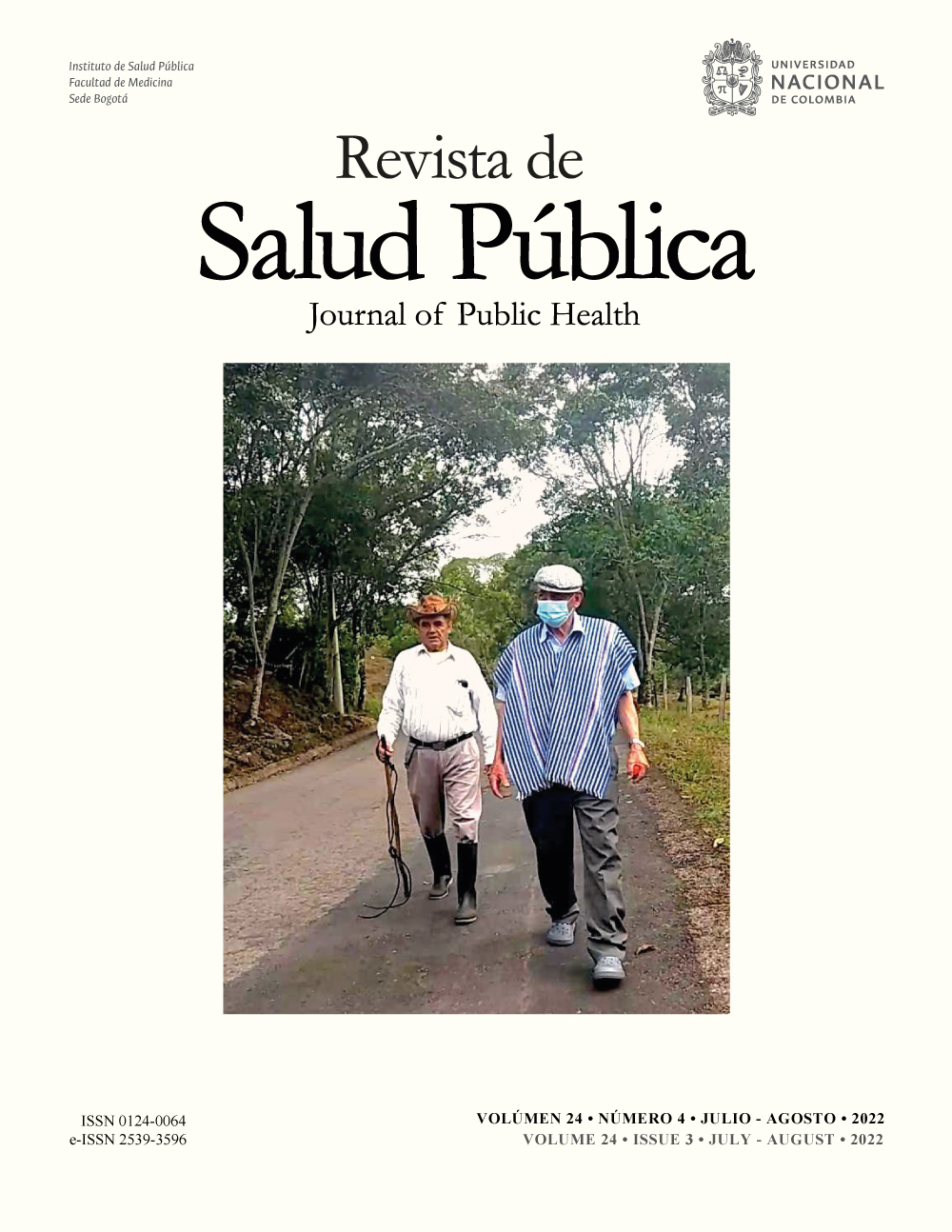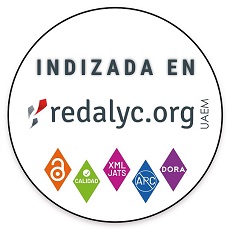Evaluación de la administración de medicamentos veterinarios en hatos lecheros de quince municipios de Cundinamarca, Colombia
Evaluation of veterinary drug stewardship in dairy herds of fifteen municipalities from Cundinamarca, Colombia
DOI:
https://doi.org/10.15446/rsap.v24n4.102018Palabras clave:
Programas de optimización del uso de los antimicrobianos, resistencia a medicamentos, drogas veterinarias, inocuidad de los alimentos (es)Antibiotic stewardship, drug resistance ungal, veterinary drugs, food safety (en)
Descargas
Objetivo Evaluar el conocimiento en el uso de Medicamentos de Uso Veterinario (MUV) de los productores ganaderos y personal involucrado en Bogotá y municipios aledaños.
Métodos Se realizó un estudio de corte transversal a través de entrevistas a operarios y productores ganaderos de una muestra de 30 hatos lecheros localizados en 15 municipios cerca de Bogotá, Cundinamarca.
Resultados Se identificó la implementación de prácticas para la administración de MUV, incluyendo parámetros que influencian su administración y conocimientos en las personas que los prescriben y administran. Se encontró que los medicamentos de mayor frecuencia fueron los antimicrobianos con 60,7%, entre los cuales se destaca el uso de penicilina y oxitetraciclina. Los MUV inyectables (parenterales) fueron las formas más frecuentes de aplicación con un 64,7%. Se identificaron 251 MUV en los hatos lecheros, de los cuales el 81,3% están compuestos por principios activos que requieren tiempo de retiro en leche y carne. Se destaca el rol del mayordomo en el cuidado animal a nivel diagnóstico y administración del tratamiento.
Conclusión El presente estudio sugiere que el uso de MUV es implementado empíricamente en producciones lecheras y podría contribuir a mediano y largo plazo a la emergencia de cepas con resistencia a MUV.
Objective To evaluate the knowledge in the antibiotic stewardship practices in livestock producers and associated staff from Bogotá and neighboring municipalities.
Methods A cross-sectional study was performed through interviews for livestock producers and staff in a sample of 30 dairy farms located in 15 municipalities near Bogota, Cundinamarca. We evaluated practice administration of veterinary drugs and knowledge in antibiotic stewardship by farm livestock managers in charge who prescribe and administer veterinary drugs.
Results The most common veterinary drugs were antimicrobials with 60.7% such as penicillin and oxytetracycline. The injectable veterinary drugs (parenteral) were the most frequently used with 64.7%. We identified 251 veterinary drugs in the dairy farms where 81.3% of active compounds require withdrawal time in the milk and meat. The butler role in animal care was highlighted at diagnostic level and treatment compliance.
Conclusion This study suggests that recommendations for veterinary drug stewardship remain empirically implemented in dairy farms which might lead to the future emergence of multidrug-resistant strains in the long and middle term.
Referencias
Clement M, Olabisi M, David E, Issa M. Veterinary pharmaceuticals and antimicrobial resistance in developing countries. In: Bekoe SO, Saravanan M, Adosraku RK, Ramkumar PK (eds.). Veterinary medicine and pharmaceuticals. London: IntechOpen; 2020. DOI: https://doi.org/10.5772/intechopen.84888
Arenas NE, Moreno Melo V. Producción pecuaria y emergencia de antibiótico resistencia en Colombia: Revisión sistemática. Infectio. 2018; 22(2):110-9. https://doi.org/10.22354/in.v22i2.717. DOI: https://doi.org/10.22354/in.v22i2.717
Bermúdez CE, Arenas NE, Moreno Melo V. Caracterización socio-económica y ambiental en pequeños y medianos predios ganaderos en la región del Sumapaz, Colombia. Rev UDCA Actual Divulg Cient. 2017; 20(1):199-208. https://doi.org/10.31910/rudca.v20.n1.2017.76. DOI: https://doi.org/10.31910/rudca.v20.n1.2017.76
Ritter DG, Acuff GR, Bergeron G, Bourassa MW, Chapman BJ, Dickson JS, et al. Antimicrobial-resistant bacterial infections from foods of animal origin: understanding and effectively communicating to consu- mers. Ann N Y Acad Sci. 2019; 1441(1):40-9. https://doi.org/10.1111/nyas.14091. DOI: https://doi.org/10.1111/nyas.14091
Morgan Scott H, Acuff G, Bergeron G, Bourassa MW, Gill J, Graham DW, et al. Critically important antibiotics: criteria and approaches for measuring and reducing their use in food animal agriculture. Ann N Y Acad Sci. 2019; 1441(1):8-16. https://doi.org/10.1111/nyas.14058. DOI: https://doi.org/10.1111/nyas.14058
Founou LL, Founou RC, Essack SY. Antibiotic Resistance in the Food Chain: A Developing Country-Perspective. Front Microbiol. 2016; 7:1881. https://doi.org/10.3389/fmicb.2016.01881. DOI: https://doi.org/10.3389/fmicb.2016.01881
Economou V, Gousia P. Agriculture and food animals as a source of antimicrobial resistant bacteria. Infect Drug Resist. 2015; 8:49-61. https://doi.org/10.2147/IDR.S55778. DOI: https://doi.org/10.2147/IDR.S55778
Castellanos LR, Donado-Godoy P, León M, Clavijo V, Arevalo A, Bernal JF, et al. High heterogeneity of Escherichia coli sequence types harbouring ESBL/AmpC genes on IncI1 plasmids in the Colombian poultry chain. PloS One. 2017; 12(1):e0170777. https://doi.org/10.1371/journal.pone.0170777. DOI: https://doi.org/10.1371/journal.pone.0170777
Ramírez NF, Keefe G, Dohoo I, Sánchez J, Arroyave O, Cerón J, et al. Herd-and cow-level risk factors associated with subclinical mastitis in dairy farms from the High Plains of the northern Antioquia, Colombia. J Dairy Sci. 2014; 7(7):4141-50. https://doi.org/10.3168/jds.2013-6815. DOI: https://doi.org/10.3168/jds.2013-6815
Giraldo-Cardona JP, Gualdrón-Ramírez D, Chamorro-Tobar I, Pulido-Villamarín A, Santamaría-Durán N, Castañeda-Salazar R, et al. Salmonella spp. prevalence, antimicrobial resistance and risk factor determination in Colombian swine farms. Pesqu Vet Bras. 2019; 39(10):816-22. https://doi.org/10.1590/1678-5150-PVB-6156. DOI: https://doi.org/10.1590/1678-5150-pvb-6156
Mattar S, Calderón A, Sotelo D, Sierra M, Tordecilla G. Detección de antibióticos en leches: un problema de salud pública. Rev. Salud Pública. (Bogotá). 2009; 11(4):579-90. https://doi.org/10.1590/S0124-00642009000400009. DOI: https://doi.org/10.1590/S0124-00642009000400009
Romero Peñuela MH, Sánchez Valencia JA. Evaluación de las buenas prácticas ganaderas en bovinos de carne en el centro de Caldas. Biosalud [Internet]. 2011 [cited 2022 Jul 6]; 10(1):52-60. https://bit.ly/3BfMEs1.
Lozano MC, Arias DC. Residuos de fármacos en alimentos de origen animal: panorama actual en Colombia. Rev Colomb de Cienc Pecu [Internet]. 2008 [cited 2022 Jul 6]; 21(1):121-35. https://bit.ly/3iEyfPy.
Pyörälä S, Taponen J, Katila T. Use of antimicrobials in the treatment of reproductive diseases in cattle and horses. Reprod Domest Anim. 2014; 49(Suppl 3):16-26. https://doi.org/10.1111/rda.12324. DOI: https://doi.org/10.1111/rda.12324
Madoz LV, Prunner I, Jaureguiberry M, Gelfert CC, de la Sota RL, Giuliodori MJ, et al. Application of a bacteriological on-farm test to reduce antimicrobial usage in dairy cows with purulent vaginal discharge. J Dairy Sci. 2017; 100(5):3875-82. https://doi.org/10.3168/jds.2016-11931. DOI: https://doi.org/10.3168/jds.2016-11931
Palma E, Tilocca B, Roncada P. Antimicrobial resistance in veterinary medicine: an overview. Int J Mol Sci. 2020; 21(6):1914. https://doi.org/10.3390/ijms21061914. DOI: https://doi.org/10.3390/ijms21061914
Opatowski L, Opatowski M, Vong S, Temime L. One-Health quantitative model to assess the risk of antibiotic resistance acquisition in asian populations: Impact of exposure through food, water, livestock, and humans. Risk Anal. 2021; 41(8):1427-46. https://doi.org/10.1111/risa.13618. DOI: https://doi.org/10.1111/risa.13618
Arenas NE, Abril DA, Valencia P, Khandige S, Soto CY, Moreno-Melo V. Screening food-borne and zoonotic pathogens associated with livestock practices in the Sumapaz region, Cundinamarca, Colombia. Trop Anim Health Prod. 2017; 49(4):739-45. https://doi.org/10.1007/s11250-017-1251-6. DOI: https://doi.org/10.1007/s11250-017-1251-6
Vásquez-Jaramillo L, Ramírez NF, Akineden Ö, Fernández-Silva JA. Presence of extended-spectrum beta-lactamase (ESBL)-producing Enterobacteriaceae in bulk-tank milk of bovine dairy farms in Antioquia, Colombia. Rev Colomb de Cienc Pecu [Internet]. 2017 [cited 2022 Jul 6]; 30(2):85-100. https://bit.ly/3XYWCrn. DOI: https://doi.org/10.17533/udea.rccp.v30n2a01
Donkor ES, Newman MJ, Yeboah-Manu D. Epidemiological aspects of non-human antibiotic usage and resistance: implications for the control of antibiotic resistance in Ghana. Trop Med Int Health. 2012; 17(4):462- 8. https://doi.org/10.1111/j.1365-3156.2012.02955.x. DOI: https://doi.org/10.1111/j.1365-3156.2012.02955.x
Furlan JPR, Dos Santos LDR, Ramos MS, Gallo IFL, Stehling EG. Fecal cultivable aerobic microbiota of dairy cows and calves acting as reservoir of clinically relevant antimicrobial resistance genes. Braz J Microbiol. 2020; 51(3):1377-82. https://doi.org/10.1007/s42770-020-00265-6. DOI: https://doi.org/10.1007/s42770-020-00265-6
De Briyne N, Atkinson J, Pokludová L, Borriello SP. Antibiotics used most commonly to treat animals in Europe. Vet Rec. 2014; 175(13):325. https://doi.org/10.1136/vr.102462. DOI: https://doi.org/10.1136/vr.102462
Torres G, Vargas K, Cuesta-Astroz Y, Reyes-Vélez J, Olivera-Angel M. Phenotypic characterization and whole genome analysis of a strong biofilm-forming Staphylococcus aureus strain associated with subclinical bovine mastitis in Colombia. Front Vet Sci. 2020; 7:530. https://doi.org/10.3389/fvets.2020.00530. DOI: https://doi.org/10.3389/fvets.2020.00530
El-Sayed A, Kamel M. Bovine mastitis prevention and control in the post-antibiotic era. Trop Anim Health Prod. 2021; 53(2):236. https://doi.org/10.1007/s11250-021-02680-9. DOI: https://doi.org/10.1007/s11250-021-02680-9
Kim J, Ahn J. Emergence and spread of antibiotic-resistant foodborne pathogens from farm to table. Food Sci Biotechnol. 2022; 31(12):1481-99. https://doi.org/10.1007/s10068-022-01157-1. DOI: https://doi.org/10.1007/s10068-022-01157-1
Herrera FC, García-López M-L, Santos JA. Characterization of methicillin-resistant Staphylococcus aureus isolated from raw milk fresh cheese in Colombia. J Dairy Sci. 2016; 99(10):7872-6. https://doi.org/10.3168/jds.2016-11322. DOI: https://doi.org/10.3168/jds.2016-11322
Awosile B, Reyes-Velez J, Cuesta-Astroz Y, Rodríguez-Lecompte JC, Saab ME, Heider LC, et al. Whole-genome sequence analysis of 4 fecal blaCMY-2-producing Escherichia coli isolates from Holstein dairy calves. J Dairy Sci. 2020; 103(1):877-83. https://doi.org/10.3168/jds.2019-16560. DOI: https://doi.org/10.3168/jds.2019-16560
Chávez de Pop VJ, Estol L, Cueva-López MT, Acero-Plazas VM. Zoonosis: Enfoque dentro del concepto de una salud. RCA. 2020; 6(1):87- 95. https://doi.org/10.36436/24223484.307. DOI: https://doi.org/10.36436/24223484.307
Dafale NA, Srivastava S, Purohit HJ. Zoonosis: an emerging link to antibiotic resistance under “One health approach”. Indian J Microbiol. 2020; 60(2):139-52. https://doi.org/10.1007/s12088-020-00860-z. DOI: https://doi.org/10.1007/s12088-020-00860-z
Emes D, Naylor N, Waage J, Knight G. Quantifying the relationship between antibiotic use in food-producing animals and antibiotic resistance in humans. Antibiotics (Basel). 2022; 11(1):66. https://doi.org/10.3390/antibiotics11010066. DOI: https://doi.org/10.3390/antibiotics11010066
Cómo citar
APA
ACM
ACS
ABNT
Chicago
Harvard
IEEE
MLA
Turabian
Vancouver
Descargar cita
CrossRef Cited-by
1. Ángela Sofía Ágredo-Campos, Cecilia Camussone, Ömer Akineden, Jorge A. Fernández-Silva, Nicolás F. Ramírez-Vásquez. (2025). Pheno- and genotypic epidemiological characterization of Staphylococcus aureus isolated from bulk tank milk in Colombia. International Dairy Journal, 160, p.106088. https://doi.org/10.1016/j.idairyj.2024.106088.
Dimensions
PlumX
Visitas a la página del resumen del artículo
Descargas
Licencia

Esta obra está bajo una licencia internacional Creative Commons Atribución 4.0.
Esta revista provee acceso libre inmediato a su contenido bajo el principio de que hacer disponible gratuitamente investigación al publico apoya a un mayor intercambio de conocimiento global.
Todos los contenidos de esta revista, excepto dónde está identificado, están publicados bajo una Licencia Creative Commons Atribución 4.0.





















